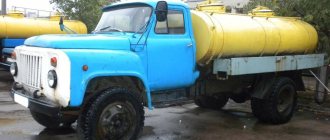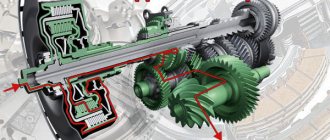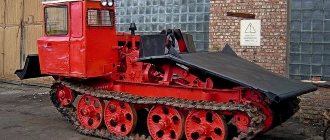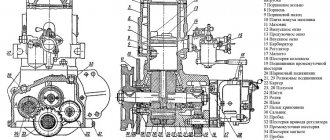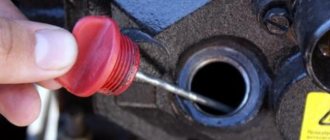Specifications
Before starting to consider malfunctions and methods for their elimination, it is worth understanding what technical characteristics the power unit has. For consideration, this issue should be referred to the technical documentation of the manufacturer.
The GAZ 3110 car with a 402 carburetor engine was equipped with a 4 and 5 speed manual gearbox. So, the power unit has a lower camshaft, a liquid closed cooling system and a dry clutch.
The most difficult factor for all motorists was that the engine has a significantly high fuel consumption. So, gas 3110 engine 402 carburetor has fuel consumption:
- The gasoline version of the power unit in the city "eats" about 13 liters. With the track, things are a little easier, here you can achieve 10 liters per "weave". If you install a "Zhiguli" carburetor instead of your own, you can reduce consumption by about 10%.
- As for vehicles operated on gas, in this case, the consumption will be about 10-12 liters of gas along the highway, and in the city the figure will increase to 13-14 liters.
How much does a 402 engine weigh?
Carburetor gasoline engine with in-line arrangement of cylinders is designed for installation on Volga passenger cars, GAZ minibuses, off-road vehicles of the Ulyanovsk Automobile Plant and RAF minibuses.
| Model | ZMZ-402.10 | ZMZ-4021.10 | ZMZ-4025.10 | ZMZ-4026.10 |
| Number of cylinders | 4 | 4 | 4 | 4 |
| Working volume, l | 2,445 | 2,445 | 2,445 | 2,445 |
| Work mode | 4 stroke | 4 stroke | 4 stroke | 4 stroke |
| Compression ratio | 8,2 : 1 | 6,7 : 1 | 6,7 : 1 | 8,2 : 1 |
| Rated power at crankshaft speed 4500 min(-1), kW (hp) | 73,5 (100) | 66,2 (90) | 66,2 (90) | 73,5 (100) |
| Maximum torque at a crankshaft speed of 2400 - 2600 min (-1), N * m (kgf * m) | 182,4 (18,6) | 172,6 (17,6) | 172,6 (17,6) | 182,4 (18,6) |
| Minimum specific fuel consumption g/kW*h (g/hp*h) | 285,6 (210) | 292,4 (215) | 299,4 (215) | 292 (215) |
| Fuel (motor gasoline) | A-93 | A-76 | A-76 | A-93 |
| Weight, kg | 181 | 181 | 184 | 184 |
Random entries - how much does it weigh:
Permission is granted to reprint and distribute materials from this site with a direct indexed link. Thank you.
Source
Troit engine - what, why and how to fight
Tripping - means that the mechanism for injecting fuel into the cylinders is broken and the mixture does not ignite correctly. This effect is quite typical for gasoline engines. So, the root cause of why the engine troit, both hot and cold, is the carburetor. This means that the fuel injection is broken.
Most likely, the needle does not hold and there is an overflow of fuel that does not burn out in the cylinders. To determine this malfunction, it is enough to either disassemble the carburetor, or unscrew and inspect the condition of the spark plugs.
Of course, when the issue was raised - ignition, then if it is troit, you should inspect for damage to this node. So, you need to unscrew the spark plugs and check for a spark. Another node in which a problem may arise is high-voltage wires, which can also fail.
The procedure for adjusting the ignition system
Label mapping
To start setting the correct ignition timing, you need to turn the crankshaft to a position that indicates 5 degrees. This is done as follows - you need to set the first cylinder at top dead center (end of the compression stroke). To do this, you need to combine the middle mark on the crankshaft pulley with the mark on the cylinder head.
This is interesting: How to adjust the carburetor on a Hooter trimmer
ATTENTION. The compression stroke on the first cylinder can be set if the distributor has not been dismantled before - by opening its cover, the slider will stand opposite the internal contact of the wire connecting to the spark plugs of the first cylinder.
If it is not possible to determine the compression stroke in this way, then it is necessary to unscrew the candle from the first cylinder and plug the hole with rags or paper. Then you should start turning the crankshaft until the paper plug is removed by the air created inside the cylinder. This will be the moment of compression.
Lead angle adjustment
Next, you need to loosen the octane corrector bolt, which is located on the distributor. A wrench of 10 is useful here. Then the lead angle is set approximately in the middle of the scale (this will be a zero indicator). Further, with the same key by 10, you need to loosen the bolt-lock of the corrector-octane plates. The next step is to turn the distributor housing so that both marks match - the red mark on the rotor head and the mark on the stator. When the housing is installed in the desired position, it is necessary to fix the distributor housing with one hand, and tighten the bolt with the other.
Checking the correct installation of the ignition
The correctness of the set ignition timing is checked while the car is moving - at a speed of 50-60 km / h the gas pedal is sharply pressed, a short-term detonation should follow (1-3 seconds). If detonation disappears after this time, then the timing is correct. You can more accurately set the ignition using a strobe.
This quick guide will help you set the ignition with your own hands without resorting to the help of specialists at home.
Why is the car jerking
Jerking of the vehicle, similar to tripping, and is mainly caused by an incorrect air-fuel mixture formation system. So, first of all, it can cause low-quality gasoline. It is worth checking how well the fuel is burned in the cylinders. To do this, it is best to unscrew and inspect the condition of the spark plugs. Also, it is recommended to check the sparking and air supply systems.
Often, experienced motorists, if the car twitches, recommend unscrewing the idle speed controller and “gasping”.
As practice shows, black smoke will come out of the exhaust pipe - this is unburned fuel. Then, if the car twitched, and after the procedure it stopped, it means that the combustible mixture does not burn out completely.
GAZ 3110 in detail about fuel consumption
When buying a car, any driver first of all pays attention to its technical characteristics. The ratio between them determines the final quality of the machine. Important in this list is the use of gasoline. That is why, let's consider the fuel consumption of GAZ 3110 per 100 km, how economical it is considered and how to reduce this vehicle consumption.
The history of the brand
This car model appeared on the market in January 1997. With its appearance, it almost completely took over the popularity and demand of the previous one in the GAZ-31029 series. The Volga presented to the people was at the MMAS-95 exhibition, which took place in the aforementioned year. With the GAZ 3110, manufacturers wanted to achieve the effect of combining modern technology and the appearance of a new model, since all previous models were not good enough in one of these criteria.
2.4i (137 hp, 210 Nm, turbo petrol) 5-mech, 2WD
In addition to the fact that fuel consumption has changed, the company impressed the consumer with other improvements.
:
- a new body was introduced;
- the interior of the cabin is made with the borrowing of foreign experience;
- improved build quality;
- improved overall performance.
Speaking of this, it should be pointed out that this model was a kind of modernization of its predecessor GAZ 31029, which at one time conquered the domestic market and broke consumer demand records for it. Along with external changes, the car received some technical ones. Before saying what fuel consumption is for 3110, it is necessary to determine which series modifications were created.
Modifications GAZ 3110
In order to satisfy the most diverse desires of consumers and not lose demand in the domestic market, it was decided to release several new models at once. Each of them had a different purpose and, accordingly, was used by the owner for different purposes. That is why the fuel consumption for GAS for various modifications was somewhat different. It is worth noting that the types of GAZ 3110 include models
:
About the engine
The production of one of the most relevant engines for cars began back in the 60s of the last century. The production of ZMZ-402 began at one plant, the process and model were improved, and over time, these engines began to be supplied to all plants specializing in the assembly of such cars as the Volga and Gazelle.
Over the past years, the brand has proved that it is not in vain that it takes its place in the market. Its main advantages:
- starts even at sufficiently low temperatures;
- ease of operation and maintenance;
- low cost of spare parts;
- reliability in application;
- the possibility of using any type of fuel.
But, the ZMZ-402 has its drawbacks. Fuel consumption on a Gazelle with a 402 engine is a fairly relevant question, often asked by the owners of such cars as the Volga and GAZelle, which made up the majority of the country's vehicles. These machines are reliable and were very popular in the not so distant past. But, today they fade into the background and gradually turn into a rarity. One of the reasons for this is fuel consumption.
Fuel consumption depending on the engine
Gas 3110 ZMZ-402 carburetor
This type of Volga is distinguished by a capacity of 100 horsepower. It is important to indicate that the volume of the power plant of the machine is at the level of 2.4 liters. Manufacturers, guaranteeing the serviceability of the engine, indicate AI-93 fuel as optimal. Interestingly, the fuel consumption of a GAZ 3110 with a 402 engine (carburetor) is 10.5 liters, and in the city
, subject to the cold season, from 11 to 13 liters for every 100 km.
GAZ 3110 ZMZ-4021 carburetor
The power of this combination of engine and car is somewhat less and reaches the mark of 90 horsepower. The machine is equipped with the same tank, the volume of which is 2.4 liters. Accordingly, the average fuel consumption of GAZ on the highway is within 10 liters, and in the city - within 12.5 liters.
This indicator is somewhat reduced compared to the previous car, but the manufacturer recommends refueling the car with A-76 brand fuel.
GAZ 3110 ZMZ-406 injector
This type of staffing is marked by high power - about 145 hp. The volume of the fuel tank remains unchanged and corresponds in volume to 2.4 liters. Thanks to the technology of dual injection, manufacturers have significantly reduced fuel consumption figures. Therefore, the consumption of gasoline for GAZ 3110 corresponds to 7 liters. / 100 km. on the highway and 12l. / 100 km. around town
.
Maintenance
In order for the 402 engine, whether it is a Gazelle or a Volga, it doesn’t matter if it works for a long time and efficiently, it is necessary to carry out timely maintenance. The engine, as you can already see, does not have a complex electronic filling and does not require highly qualified maintenance. What points should be paid special attention to?
- As already mentioned, every 20 thousand you need to stretch the head to the block. This is due to the natural crushing of the cylinder head gasket. In this case, the nuts are pulled from the middle to the ends of the head and always on a cooled engine. A hot engine is a hot block and head, and, of course, a slightly smaller gap between them. In addition, it is recommended to first simply tighten the nuts, and in the second step, make a control tightening with a given moment of force.
- It must be inspected, and if loosened, the timing cover is tightened. The bolts rotate starting from the middle. Valve clearances are checked.
- With an increase in engine consumption and a decrease in power, attention should be paid to deposits inside the combustion chambers. This happens more often on worn engines when the oil rings leak a lot of oil. In this case, it is best to remove the head and clean it from soot. Do not forget that if the head is removed, the valves must be rubbed.
Ways to reduce fuel consumption
Although the consumption indicators of this model are somewhat different from what the actual fuel consumption of GAZ 31029 is, the rules for reducing them are the same:
- cleanliness of all parts of the vehicle;
- timely replacement of components;
- selection of a slow type of driving;
- tire pressure control;
- neglect of additional cargo;
- avoid adverse environmental conditions.
All the data we used was created based on user feedback. When considering the question of what fuel consumption the GAZ 3110 has per 100 km, we can say that there is no definite answer. It all depends on the modification of the brand and the engine that is used in it. However, a large number of cars are still marked by economy at the moment.
.
Real fuel consumption on the Volga GAZ-3110
Gorky Automobile Plant in 1996 presented a new modification of the middle class sedan - GAZ-3110. The model is a continuation of the modernized Volga line, which was based on the predecessor GAZ-31029. The car was not only outwardly transformed, but also received perfect technical equipment, previously inaccessible to older versions of the car. Already in 1999, the first restyling was carried out, during which the Volga underwent significant changes in design: the wings, the shape of the roof and the bumper became more sophisticated.
In 2003, they decided to refine the sedan once again, but this time the efforts of the engineers were aimed at improving the technical component. The body was primed and painted in accordance with the latest technologies, thus, the manufacturer managed to increase its resistance to corrosion. For endurance and capacity, the model received public attention from motorists. The only question that remains relevant is what is the fuel consumption of the GAZ-3110 per 100 km of track.
Consumption rate: what figures did the manufacturer assure?
The line of power units "Volga" includes five different assemblies with a displacement of 2.3 to 2.5 liters. The most popular were versions of cars with the legendary 402 engine, which was equipped not only with cars of the Volga family, but also with the Gazelle family, and Latvia minibuses. The engine power is 100 horsepower, which allows the vehicle to reach a speed of 100 km/h in 15 seconds. For that time it was really an outstanding figure. After some time, the GAZ-3110 began to be equipped with the injection ZMZ-406.
Official urban/extra-urban fuel consumption rate:
- ZMZ-402 - 13/9 liters;
- ZMZ-4021 - 12/8 liters;
- ZMZ-406 - 11.5 / 7.5 liters.
ZMZ-4021 is characterized by less power - 90 horsepower. Due to technical changes, the 2.4-liter engine began to consume less gasoline, but the official rate was still at a fairly high level, which did not suit many domestic drivers. Turbodiesel power units GAZ-560 and GAZ-5601, produced under the license "Stery", were less popular. People's distrust of the quality of diesel fuel left its mark on the number of sales of GAZ-3110 modifications with a diesel engine under the hood. Due to the low level of consumption of diesel fuel - 8 liters in the city, there was still a small demand for them.
This is interesting: How to clean the carburetor on a scooter
History of engine development
The 402 engine has been installed on cars since 1958. At that time, it had a different designation - ZMZ-21A and ZMZ-24D, but it was still the same engine. The prototype was an even earlier modification, on which the designers worked in 1954-1955. Then it was a completely new version of the engine for the GAZ-56 car, which did not even leave the assembly line. The 402nd unit became known only in 1980.
The main representatives of the 402 line are:
- ZMZ-402.10 as the main basic option for AI-92 gasoline.
- ZMZ-4021.10, consuming A-76 fuel.
- ZMZ-4022.10, which has a new type of ignition, the so-called prechamber-torch.
During the operation of 402.10 engines, they often tried to use cheaper fuel. To do this, by the forces of car owners, the engine was remade for gasoline with a lower octane number. As for the flagship of the 402 line - ZMZ-4022.10, there are opinions that the idea of \u200b\u200bprechamber-torch ignition was taken from Honda's Japanese colleagues.
Fuel consumption of GAZ-3110 Volga according to owners reviews
The maintainability of the Volga and the availability of powerful power units, combined with a reasonable price, are the main factors contributing to the interest of potential buyers in purchasing this car. GAZ-3110 motors, aggregated by 5-speed mechanics, are quite reliable and unpretentious. Their dynamism is not a significant advantage today. But the increased "gluttony" is a serious drawback. To determine the actual level of fuel consumption of the GAZ-3110 Volga, it is best to refer to the reviews of car owners who have experienced all the advantages and disadvantages of the car from their own experience.
Modification with a carburetor
- Yuri, Kursk. I work in a taxi company, I myself drive a GAZ-3110 with a 402 carburetor. The cost is high and not everyone will like it. But I like the power of this machine, it gives a feeling of freedom or something. In winter, I somehow got into a traffic jam, in general, it turned out to be a nervous day - as a result, I burned 16 liters. True, such cases are isolated and extremely rare. Basically I fill up with 92-m gasoline, burns 13-14 liters in the worst case. On the highway at a speed of 120 km / h "eats" 9 liters per 100 km.
- George, Tula. I have owned the car since 1998. The engine has never been opened yet. Very reliable and stable car. It often breaks down on trifles, but getting the right parts is not difficult. Moreover, everything is repaired independently, in a garage, in a good environment. The engine is powerful, about 100 horses, it is worth pressing the gas - it vomits from a place. But it also "eats" according to its liking - 12 liters per hundred in warm weather, up to 15 liters in winter, taking into account warming up.
- Maxim, Yekaterinburg. The car was inherited from my father, I drive it literally every day. Gearbox 5-speed, engine ZMZ-4021. With a full drain of the engine in the city, about 16 liters are fired. In the extra-urban cycle, the figures are more adequate - 12 liters per 100 kilometers on average. Although, also a rather big indicator. I don't want to part with this car. Do you think you can switch to gas?
- Stanislav. Many are interested in the question, what is the fuel consumption of a GAZ-3110 with a 402 engine carburetor? I will give some recommendations and practical advice based on my experience, and I have it not so small! I have been driving the Volga for more than thirty years, there were various modifications and models. Today I am working on a GAZ-3110 - an attractive car, which, for various reasons, has not been able to fully reveal its potential. AI-92 has always been refueled, it consumes about 13-14 liters on the highway! I like to drive fast - hence the result. In the city, there is a full guard for those who like to save money - they almost don’t “eat” less than 16 liters per hundred. With warming up in winter, the figure can generally reach up to 18 liters.
Modification with an injector
- Valentin, Cheboksary. I drive a 2003 Volga with a 406 injection engine. The tank is set to 70 liters. The car is spacious, comfortable, and the engine pulls and is quite reliable. Already did a major overhaul, before that it was about 300 thousand kilometers. Gasoline consumes a maximum of 13 liters per 100 km in the city during severe frosts, and an average of 10 liters. In the warm season, the "appetite" of the car is much less - 9 liters is the upper limit. I focus on 8.2-8.3 per hundred. On the highway 8 liters, if properly "flooded".
- Sergei, Moscow. Before buying domestic vehicles, I also looked for answers to the question of what is the fuel consumption of a GAZ-3110 with an injector 406. I decided to take a new version so as not to mess with the car in the future. I monitor the pressure in the tires, this factor plays an important role in the level of fuel consumption of the Volga. At a pressure of 2.5 throughout the year, the lowest rates of "gluttony" are 8-9 liters per 100 km in Moscow. In traffic jams and in winter, often 10 liters, but, in my opinion, this is not critical. Rubber R15 195/65.
- Maxim, Saratov. I have a car with a ZMZ-406 engine, an injector, a 5-speed manual, a mileage of 168,000 km. Burns about 11-12 liters in the city, up to 10 liters on the highway. I sometimes drive loaded, the listed indicators are at full / partial load. Empty up to ten liters per 100 km I fit. The car is good, roomy, but "eats" too much.
- Alexander, Irkutsk. I recently purchased a Volga 406th engine, 5-mortar, with a mileage of 200 thousand km. Consumption from the very beginning of operation was in the region of 12-13 liters, with regard to trips within the city. In summer, the "appetite" is somewhat dulled and drops to a more or less acceptable 9.5-10 liters. But still, it was unprofitable for me to refuel the car with such frequency, so I decided to switch to gas and installed HBO. Now, on average, it burns 16 liters each - insignificant, but savings. Of course, power figures have dropped slightly.
Design features
Design features and differences from its predecessors The first thing that catches your eye when the hood is open is the water pump, which has moved from the head to the cylinder block itself. Now she does not have a characteristic horn, the supply and output pipes look to the sides. The liquid in the cooling system circulates under pressure not only in the head, but also in the block itself. To compensate for expansion, an expansion tank is provided in the system. The engine got an oil cooler located in front of the main one. This improved the uniformity of engine temperature loads. However, many garage gurus consider the innovation to be detrimental, as it steals precious units of oil pressure, they say. This is a delusion caused by a misunderstanding of the principles of hydrodynamics. The valves received reinforced twin springs, which partially leveled the problem of their hanging at high speeds and increased the reliability of the timing as a whole, since the destruction of the external spring no longer caused the valve to fail into the cylinder. The intake valves, like those of the 24D, remained 47 mm in diameter, but the exhaust valves were increased to 39 mm. Valve stem seals on the ZMZ 402 are already installed on all valves, and not just the intake valves, like their predecessors. The rocker axle received two additional end posts, which made the assembly more reliable and reduced vibration loads on the axle. The K 151 carburetor (hereinafter K 151C) appeared in the power system, about the advantages and disadvantages of which so many copies were broken that they would make a good fence. The problem is that this carburetor, for all its remarkableness, is in itself quite complex in design and extremely sensitive to fuel quality and correct tuning. In addition, old-school volgovods are frightened by the abundance of tubes, hoses and the electrical component of the device. By 126, in this respect, it was much simpler.
The air filter on ZMZ 402 is dry, with replaceable paper elements. Modifications and applicability The engine was produced for a long time and over the years on the assembly line was adapted to a wide variety of needs. It was installed: ● on cars Volga 2410, 31029, 3102, 3110 and even on the first issues 31105; ● UAZ cars; ● minibuses and light trucks GAZelle; ● stationary units (generators, compressor stations, etc.); ● light trucks GAZelle.
GAZ 3110 fuel consumption reviews
GAZ 3110 Volga is a Russian rear-wheel drive sedan of the middle class, the production of which at the Gorky Automobile Plant started back in 1997. This car was a modernized version of the Volga 31029. The serial production of the car was discontinued in 2005 due to low demand. The car is the only passenger car that the Gorky Plant has ever created, since the activity of the enterprise was mainly aimed at creating working trucks.
The process of adjusting the angles of thermal gaps
For those who are wondering how to adjust the valves on a car with a 402 engine, the entire process will be presented below in detail. It is important to remember that the process itself should be performed on a cold engine, since a combustible mixture can burn a motorist on a warm engine. Valve adjustment on a 402 engine is performed in the following way:
- Disconnecting the hose. The first step is to disconnect all hoses suitable for the valve cover, as well as the accelerator cable.
- Removing the air filter and valve cover. Then you should remove the air filter with the housing, and unscrew the 6 bolts securing the valve cover.
- Removing spark plugs.
- Setting the first cylinder to TDC. The next step in the adjustment process will be to set the first cylinder to top dead center (TDC). To do this, it is necessary that the third mark on the crankshaft pulley coincides with the mark on the body of the engine block. This is done by turning the crankshaft.
- Valve adjustment sequence. The valve adjustment procedure is as follows: 1, 2, 4, 6, the next step is to turn the crankshaft one full turn clockwise until the marks match. Further, 3, 5, 7, 8 valves are regulated.
- adjustment process. Using a socket for 11 or a screwdriver, it is necessary to hold the adjusting screw, and at this moment unscrew the nut that fixes it. Using a feeler gauge of the right size, measure (the feeler should move with little effort), if the measurement of the thermal gap is normal, then you can proceed to the next valve.
- Assembly work. The next step is to assemble in the reverse order, i.e. the spark plugs, valve cover with a new gasket are installed back, but the bolts must be tightened according to the recommended tightening torques (this figure is 0.5-0.8 N.m (kg.m)), air filter and hoses.
- Checking with the engine running. Now you should start the internal combustion engine and give it a little time to work until it warms up completely, then listen to its work. If there is no metallic ringing or dull clatter, this will mean that the adjustment of the thermal clearances is correct.
This is interesting: Which shock absorbers are better gas or oil
In this way, the valves are adjusted and the correct operation of the internal combustion engine is adjusted. This procedure is suitable for all cars with a 402 engine, whether it is a GAZ 3110 (Volga) or a GAZelle.
GAZ 3110 ZMZ-402
GAZ 3110 was equipped with a ZMZ-402 engine with a displacement of 2,445 cc and a power of 100 hp. The maximum torque of the motor is -172 N.m / 2500 rpm, the power system is the K-151, K-126 carburetor., The gearbox is a five-speed mechanics. The maximum developed speed is 147 km / h, the acceleration time from zero to hundreds is 19 seconds. Fuel consumption: urban cycle - 14 liters, extra-urban cycle - 8.8 liters, combined cycle - 11 liters.
Real fuel consumption GAZ 3110 ZMZ-402. Reviews
- Andrey. Kemerovo. "Volga" in 2001 with the engine ZMZ-402 I got for only forty thousand. The engine was in excellent condition, but the body had to be almost completely repainted. In general, the car is not bad, but the fuel consumption is certainly too big. In my city in the summer, at least fourteen liters come out, and in winter in general up to sixteen. On the highway, of course, the consumption is less - somewhere around 9-10 liters per hundred mileage.
- Sergey. Barnaul. I bought a Volga for work and, frankly, immediately regretted it. Despite the fact that the car was new, its fuel consumption in most cases exceeded the data indicated in the passport. I got about 15 liters in the city, and at least nine on the highway. Tired of constantly driving from gas station to gas station and therefore sold the car in just a year.
- Alexander. Nizhny Novgorod. My father gave me a GAZ 3110 with a ZMZ-402 engine. Prior to that, he himself rode it on business trips, but he took excellent care of the car, so I didn’t have to really look under the hood or change consumables. Of course the car is comfortable, with a spacious interior and excellent stability, but its dimensions do not suit me completely. On his "Volga" he barely drove into the yard and hardly moved around the city during heavy traffic. As for fuel consumption, it seems to me that the Volga eats like a cruiser! In the city, I sometimes got up to 16 liters, and on the highway at least nine.
- George. Murmansk. I had a Volga with a 402 engine for only a few months. Bought it from a friend just because he offered a penny price. However, after sitting behind the wheel, I realized that this car during long trips needs to be refueled several times a day. She “eats” a lot and it seems to me that in terms of consumption she can be compared with the newest foreign-made jeeps. I personally got 14-15 liters within the city and somewhere around 9-9.5 liters on the highway.
- Vladislav. Pskov. I bought a Volga with a ZMZ-402 engine in the cabin and was immediately very pleased with the car. Comfortable, moderately tough, stable and easy to manage in all weather conditions. However, the train only a year began to increasingly look under the hood due to minor and not very breakdowns. Tired of changing “native” parts and, of course, always refueling a car. The appetite of this "swallow" is very good! I got 14-15 liters in the city (with normal traffic) and on the highway at least nine liters per hundred mileage.
- Anton. Moscow. My father dreamed of the Volga for half his life, and finally, in 2000, he bought it new from the salon. Initially, his joy knew no bounds, but literally a year later, systematic breakdowns began. When my father realized that he spends more time under the car than in it, he decided to sell. In addition, the consumption of gasoline was considerable: up to 15 liters came out in the city (during frosts), and on the highway all ten flew out into the pipe.
- Egor. Bryansk. In 2001, I bought a new Volga from the salon and was very happy with my purchase. The car is very good, hardy, stable with good cross-country ability and maneuverability. However, in order to comfortably move around the city, this “swallow” needs to be constantly refueled. On long trips, I sometimes got three or four refueling. Tired of "feeding" the "Volga" and therefore sold it to a neighbor. My fuel consumption was as follows: in the city - 14-15 liters, on the highway - 9 liters per hundred kilometers.
- Valentine. Lipetsk. All my life I have been driving domestic cars and now I decided to buy a new Volga from the salon. The car with the ZMZ-402 engine stayed with me for only six months, after which I sold it. What can I say, there is no dynamics, in overclocking I’m already tight-lipped about the dimensions, which you don’t feel at all. In addition, this car “eats” like for two. In my city, sometimes up to 16 liters came out, and on the highway at least 9-10 liters per hundred mileage.
- Peter. Kostroma. I have long dreamed of buying a GAZ 3110 with a ZMZ-402 engine, and only after I got it, I realized why it was so quickly taken out of production. It's not a car, it's some kind of tractor! Not only does it barely accelerate, it also “eats” fuel with great appetite. I rode my "Volga" for only a year, after which I sold it and, as they say, "crossed myself." In terms of consumption, I got somewhere around 14-15 liters in the city and at least ten on the highway.
- Victor. Belgorod. It's not a bad car, but I wouldn't buy one for myself. I rode the Volga with the ZMZ-402 engine for three years, and then only because it was working. He drove the boss on business trips and meetings, and in between trips he dug under the hood. Something constantly broke, and for all the time I personally replaced half of the “native” parts in it. Fuel consumption, as for me, is generally crazy: the urban cycle is 14-16 liters, the extra-urban cycle is 9-10 liters per hundred.
This is interesting: Form of power of attorney for a car
Engine ZMZ 402 - the last of the Mohicans
In 1981, a new engine was installed on the conveyor of the Zavolzhsky Motor Plant. ZMZ 402
did not show the world any revolutionary technical solutions, but it was the most advanced engine in the line of glorious engines leading its pedigree from the GAZ 21A. It concentrated all the proven and well-proven technical solutions found by the engineers of ZMZ and the engine division of GAZ. So the motor turned out to be quite successful, traditionally unpretentious for ZMZ, easy to operate and maintain, although not without some shortcomings, with which, however, one could live and even drive.
GAZ 3110 ZMZ-406
GAZ 3110 ZMZ-406 was equipped with a five-speed manual gearbox and an engine with a displacement of 2.4 liters. The engine power was 145 hp, and the torque increased to 209 Nm. Control system - distributed injection with microprocessor control. The maximum speed of the car is 155 km / h, acceleration from zero to hundreds is carried out in 15.3 seconds. Thanks to the dual injection system, the developers managed to significantly reduce fuel consumption: urban cycle - 12 liters, extra-urban cycle - 7 liters per hundred kilometers. Given the presence of an electronic fuel supply control system, it is recommended to repair the engine only with the help of specialized specialists.
Real fuel consumption GAZ 3110 ZMZ-406. Reviews
- Denis. Stavropol. I have had a Volga 1999 with a ZMZ-406 engine for more than ten years. Today I use the car to work in the taxi service. What can I say very pleased with the machine. Roomy interior and trunk, comfortable seats, moderately stiff suspension and, of course, not expensive maintenance. As for fuel consumption, I basically get it: 12 liters in the city, and about 7-8 liters per hundred kilometers on the highway.
- Stepan. Kaluga. I bought a GAZ 3110 in a "luxury" complex thirteen years ago and ride to this day. The car completely suits me, it has good cross-country ability, stability and controllability, in addition, the interior is spacious and comfortable. As for maintenance, it costs a penny, especially if you do at least minor repairs yourself. In terms of gasoline consumption, I personally get this: in the city 12-13 liters, on the highway - 7-8 liters per hundred kilometers.
- Stas. Belgorod. On such a machine, I drove my boss for five years. To be honest, I didn't really like the car. Accelerates reluctantly, the engine runs, and the stove warms up the interior slowly. In addition, despite the large volume of the cabin, there is no comfort in it and close. At a speed of 70 km / h, the interior trim begins to rattle and creak. My fuel consumption turned out to be not small: up to 15 liters in the city (winter period) and at least 8-9 on the highway.
- Nicholas. Vladimir. GAZ 3110 2000 was bought by my father. Today we still use it, but mainly for trips to the country or fishing. Over the years, there have been no particularly serious breakdowns, so they practically did not look under the hood. We do minor repairs on our own, so maintenance costs a penny. In terms of consumption, I can say the following: I personally get within 13 liters in the city and no more than eight on the highway.
- Vitaly. Nizhnevartovsk. GAZ 3110 of 1999 with the ZMZ-406 engine is my first car that I purchased for personal funds. I like the car, of course, it's not a foreign car with climate control and other "bells and whistles", but still you can drive quite comfortably. Gasoline consumption I get as according to my passport (city 12 liters, extra-urban cycle - 7 liters), despite the fact that the car has already seen the signs.
- Timur. Eagle. I bought a Volga 3110 with a ZMZ 406 engine (injector) from a neighbor. The car was in the garage for a long time, so I had to sort it out almost completely. In addition, he threw out the old interior and put in more comfortable seats, a stereo system and automatic windows. I have been riding my “swallow” for five years now and I am quite pleased with it. In terms of fuel consumption, I get 12-13 liters in the summer in the city, and up to 15 liters per hundred in winter.
- Maksim. Kazan. I wanted a large but inexpensive car, so I chose the Volga 3110. What can I say, the car is very good, has good stability and maneuverability and is easy to control in any weather. In addition, maintenance costs mere pennies, especially if you fix the main breakdowns yourself. Gasoline consumption I get this: urban cycle - 12-13 liters (summer); suburban cycle - 7-8 liters per hundred kilometers.
- Oleg. Peter. I work on the "Volga" 3110 in the taxi service. As for me, the car is not even a bad high-spirited, hardy, not picky and not expensive to maintain. In addition, the interior is very roomy, I can comfortably accommodate five passengers at once. For gasoline, the consumption is as follows: urban cycle 12-13 liters, extra-urban cycle 7-8 liters.
- Victor. Irkutsk. For a long time I was looking for a big car with a spacious interior and a roomy trunk for work, and a friend offered to buy a Volga 3110 from him with a ZMZ-406 injection engine. I do repairs, so I constantly load the car with building materials and tools. Everything in the car suits me except fuel consumption. In winter, in the city, sometimes it turns out up to 16 liters, on the highway, less than eight has never come out.
- Eugene. Moscow. The neighbor was going to buy himself a new foreign car and offered me his Volga 3110 for a ridiculous price. Of course, I agreed and I think that not in vain. The car is good, easy to manage, high-spirited and hardy, in addition, it feels confident in any snowfalls on the road. As for the consumption of gasoline, I basically get up to 13 liters in the city, and a little more than seven on the highway.
